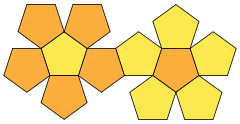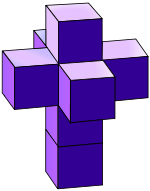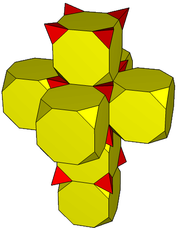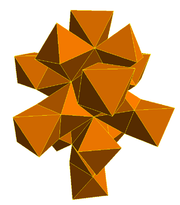
Net (polyhedron)
Encyclopedia


Geometry
Geometry arose as the field of knowledge dealing with spatial relationships. Geometry was one of the two fields of pre-modern mathematics, the other being the study of numbers ....
the net of a polyhedron
Polyhedron
In elementary geometry a polyhedron is a geometric solid in three dimensions with flat faces and straight edges...
is an arrangement of edge-joined polygon
Polygon
In geometry a polygon is a flat shape consisting of straight lines that are joined to form a closed chain orcircuit.A polygon is traditionally a plane figure that is bounded by a closed path, composed of a finite sequence of straight line segments...
s in the plane which can be folded (along edges) to become the faces of the polyhedron. Polyhedral nets are a useful aid to the study of polyhedra and solid geometry
Solid geometry
In mathematics, solid geometry was the traditional name for the geometry of three-dimensional Euclidean space — for practical purposes the kind of space we live in. It was developed following the development of plane geometry...
in general, as they allow for models of polyhedra to be constructed from material such as thin cardboard.
It is a long-standing open question whether or not every convex polyhedron P (one without "dents" – in other words, all dihedral angles between the edges are ≤ 180 degrees) has a net: whether the surface P may be cut along edges and unfolded flat to a planar polygon
Polygon
In geometry a polygon is a flat shape consisting of straight lines that are joined to form a closed chain orcircuit.A polygon is traditionally a plane figure that is bounded by a closed path, composed of a finite sequence of straight line segments...
(without overlap). (This system of edges is sometimes denoted as the polyhedron's unfolding.) The problem was first explicitly posed in a paper by Shephard.
The history of and progress on this question is discussed in Part III of Geometric Folding Algorithms.
If the restriction that the cuts be along polyhedron edges is relaxed to permit cuts through the interior of faces, then there are several known methods to cut and unfold a convex polyhedron to a planar polygon. For example, cutting along the cut locus of a point suffices.
Also, the shortest path over the surface between two points on the surface of a polyhedron corresponds to a straight line on a suitable net. The net has to be such that the straight line is fully within it, and one may have to consider several nets to see which gives the shortest path. For example, in the case of a cube
Cube
In geometry, a cube is a three-dimensional solid object bounded by six square faces, facets or sides, with three meeting at each vertex. The cube can also be called a regular hexahedron and is one of the five Platonic solids. It is a special kind of square prism, of rectangular parallelepiped and...
, if the points are on adjacent faces one candidate for the shortest path is the path crossing the common edge; the shortest path of this kind is found using a net where the two faces are also adjacent. Other candidates for the shortest path are through the surface of a third face adjacent to both (of which there are two), and corresponding nets can be used to find the shortest path in each category.
Higher dimensional polytope nets
The geometric concept of a net can be extended to higher dimensions. Tesseract Tesseract In geometry, the tesseract, also called an 8-cell or regular octachoron or cubic prism, is the four-dimensional analog of the cube. The tesseract is to the cube as the cube is to the square. Just as the surface of the cube consists of 6 square faces, the hypersurface of the tesseract consists of 8... |
 Truncated tesseract Truncated tesseract In geometry, a truncated tesseract is a uniform polychoron formed as the truncation of the regular tesseract.There are three trunctions, including a bitruncation, and a tritruncation, which creates the truncated 16-cell.... |
 24-cell |
For example, a net of a polychoron
Polychoron
In geometry, a polychoron or 4-polytope is a four-dimensional polytope. It is a connected and closed figure, composed of lower dimensional polytopal elements: vertices, edges, faces , and cells...
, or four-dimensional polytope
Polytope
In elementary geometry, a polytope is a geometric object with flat sides, which exists in any general number of dimensions. A polygon is a polytope in two dimensions, a polyhedron in three dimensions, and so on in higher dimensions...
, is composed of polyhedral cells that are connected by their faces and all occupy the same three-dimensional space, just as the polygon faces of a net of a polyhedron are connected by their edges and all occupy the same plane. The tesseract
Tesseract
In geometry, the tesseract, also called an 8-cell or regular octachoron or cubic prism, is the four-dimensional analog of the cube. The tesseract is to the cube as the cube is to the square. Just as the surface of the cube consists of 6 square faces, the hypersurface of the tesseract consists of 8...
, the four-dimensional cube, is used prominently in a 1954 painting by Salvador Dali
Salvador Dalí
Salvador Domènec Felip Jacint Dalí i Domènech, Marquis de Púbol , commonly known as Salvador Dalí , was a prominent Spanish Catalan surrealist painter born in Figueres,Spain....
, Crucifixion (Corpus Hypercubus)
Crucifixion (Corpus Hypercubus)
Crucifixion was painted in 1954 by Salvador Dalí, and depicts the crucified Jesus upon the net of a hypercube. Gala , is the figure in the bottom left, who stands looking up to the crucified Jesus. The scene is depicted in front of the bay of Port Lligat.The painting is in the Metropolitan Museum...
.
Whether or not every four-dimensional polytope
Polytope
In elementary geometry, a polytope is a geometric object with flat sides, which exists in any general number of dimensions. A polygon is a polytope in two dimensions, a polyhedron in three dimensions, and so on in higher dimensions...
may be cut along the two-dimensional faces shared by its three-dimensional facets, and unfolded into 3D to a single nonoverlapping polyhedron (as in the above unfolding of the tesseract), remains unknown, as does the corresponding question in higher dimensions.
External links
- Nets: A Tool for Representing Polyhedra in Two Dimensions
- Regular 4d Polytope Foldouts
- Editable Printable Polyhedral Nets with an Interactive 3D View
- Paper Models of Polyhedra
- Unfolder for BlenderBlender (software)Blender is a free and open-source 3D computer graphics software product used for creating animated films, visual effects, interactive 3D applications or video games. The current release version is 2.60, and was released on October 19, 2011...
- Unfolding package for MathematicaMathematicaMathematica is a computational software program used in scientific, engineering, and mathematical fields and other areas of technical computing...

